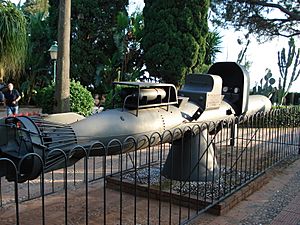Raid on Alexandria (1941) facts for kids
Quick facts for kids Raid on Alexandria |
|||||||
|---|---|---|---|---|---|---|---|
| Part of the Battle of the Mediterranean of World War II | |||||||
 An Italian manned torpedo |
|||||||
|
|||||||
| Belligerents | |||||||
| Commanders and leaders | |||||||
|
|||||||
| Strength | |||||||
| Fleet in harbour |
|
||||||
| Casualties and losses | |||||||
|
6 crewmen captured | ||||||
The Raid on Alexandria was a daring attack during World War II. On December 19, 1941, brave divers from the Italian Navy used special underwater vehicles called manned torpedoes to sneak into the harbor of Alexandria, Egypt. Their mission was to damage two big British warships, and they succeeded!
Contents
The Plan to Attack
On December 3, 1941, an Italian submarine named Scirè left its base in La Spezia, Italy. It was commanded by Lieutenant Junio Valerio Borghese. The submarine was carrying three special underwater vehicles. The Italians called these vehicles maiali, which means "pigs."
The Scirè secretly stopped at Leros island in the Aegean Sea. There, six expert divers joined the submarine. They were the crews for the three "pigs."
- Luigi Durand de la Penne and Emilio Bianchi were on maiale number 221.
- Vincenzo Martellotta and Mario Marino were on maiale number 222.
- Antonio Marceglia and Spartaco Schergat were on maiale number 223.
The Attack on Alexandria
On December 19, the Scirè submarine got very close to the harbor of Alexandria. It was about 1.3 miles (2.1 km) away and 15 meters (49 feet) deep. From there, the submarine released the three manned torpedoes. The divers waited for their chance to enter the naval base.
Their chance came when the British opened their defenses to let three of their destroyers pass. The Italian divers quickly slipped inside the harbor.
De la Penne and Bianchi's Mission
Luigi Durand de la Penne and Emilio Bianchi faced many problems. First, their torpedo's engine stopped working. The two frogmen had to push the heavy torpedo by hand! Then, Bianchi had trouble with his oxygen tank and had to go to the surface. This meant de la Penne had to push the "pig" all by himself.
He managed to push it all the way to the battleship HMS Valiant. He successfully placed a limpet mine right under the ship's bottom. After placing the mine, both divers had to surface. Bianchi was hurt, and they were quickly discovered and captured by the British.
The British questioned them, but both divers refused to say anything. They were locked in a room on the Valiant, below the water line. By chance, this room was right above where de la Penne had placed the mine! About 15 minutes before the mine was set to explode, de la Penne asked to speak with the Valiant's captain, Charles Morgan. He told the captain that the ship was about to explode but still refused to give more details. He was sent back to the room. When the mine exploded, neither diver was badly hurt. De la Penne only got a small cut on his head.
Marceglia and Schergat's Mission
Meanwhile, Marceglia and Schergat had also succeeded. They attached their mine five feet (1.5 meters) under the battleship HMS Queen Elizabeth. They managed to leave the harbor safely by 4:30 AM. They pretended to be French sailors to avoid suspicion. However, two days later, the Egyptian police captured them in Rosetta. They were waiting for the Scirè to pick them up. The Egyptian police then handed them over to the British.
Martellotta and Marino's Mission
Martellotta and Marino searched for an aircraft carrier they thought was in Alexandria, but they couldn't find it. So, they decided to attack a large oil tanker instead. This tanker was the Norwegian ship Sagona, which weighed 7,554 tons. Marino attached their mine under the tanker's back end at 2:55 AM. Both divers managed to get to shore without being caught at first. But later, they were arrested at an Egyptian police checkpoint.
In the end, all six Italian divers were captured. However, they had successfully damaged two very important British battleships. The Queen Elizabeth was out of action for 18 months, and the Valiant was out for seven months. Eight crew members on the Queen Elizabeth were killed. The Sagona tanker lost its back section, and the destroyer HMS Jervis, which was refueling next to it, was also badly damaged. The two big battleships didn't sink, but they were out of the fight for many months.
What Happened Next
This raid was a big win for the Italian navy. For the next six months, the Italian fleet had more control of the eastern and central Mediterranean Sea. This was a major change in the war for the Allies.
The Valiant was taken to a floating dock on December 21 for quick repairs. It stayed in Alexandria until April 1942, then sailed to Durban, South Africa. By August, it was helping with exercises to defend East Africa and during the Battle of Madagascar.
The Queen Elizabeth was in a drydock in Alexandria for temporary repairs until late June. Then, it sailed to the United States for more repairs and a refit, which finished the following June. The final work was completed in Britain.
The Jervis destroyer was repaired and ready for action again by the end of January. The Sagona tanker was towed back to England, but its repairs weren't finished until 1946.
The Raid in Movies
The exciting story of this attack has been shown in movies:
- The film The Silent Enemy (1958) shows the attack at the very beginning.
- Another movie, The Valiant (1962), is about the damage to HMS Valiant in Alexandria harbor.
- There's also an Italian movie from 1953 called I sette dell'Orsa Maggiore that tells the story of the attack.
See also
- Lionel Crabb
- Operation Source

